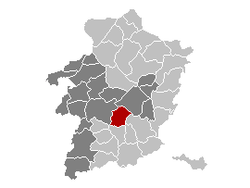Diepenbeek
| Diepenbeek | |||
|---|---|---|---|
| Municipality | |||
|
Diepenbeek town hall | |||
| |||
 Diepenbeek Location in Belgium | |||
|
Location of Diepenbeek in Limburg  | |||
| Coordinates: 50°54′N 05°24′E / 50.900°N 5.400°ECoordinates: 50°54′N 05°24′E / 50.900°N 5.400°E | |||
| Country | Belgium | ||
| Community | Flemish Community | ||
| Region | Flemish Region | ||
| Province | Limburg | ||
| Arrondissement | Hasselt | ||
| Government | |||
| • Mayor | Patrick Hermans (Puur Diepenbeek) | ||
| • Governing party/ies | Puur, Open VLD, N-VA, CD&V | ||
| Area | |||
| • Total | 41.19 km2 (15.90 sq mi) | ||
| Population (1 January 2016)[1] | |||
| • Total | 18,906 | ||
| • Density | 460/km2 (1,200/sq mi) | ||
| Postal codes | 3590 | ||
| Area codes | 011 | ||
| Website | www.diepenbeek.be | ||
Diepenbeek (Limburgish: Diepenbik) is a municipality located in the Belgian province of Limburg near Hasselt. On January 1, 2012, Diepenbeek had a total population of 18,337. Its total area is 41.19 km² which gives a population density of 430 inhabitants per km².
The municipality includes the communities and hamlets of Bijenberg, het Crijt, Dorpheide, Keizel, Lutselus, Pampert, Piannesberg, Reitje, Rooierheide, Rozendaal, and Zwartveld.
It is home to Hasselt University, slowly expanding towards Hasselt itself. The Limburg Science Park is located on the university campus.
References
- ↑ Population per municipality as of 1 January 2016 (XLS; 397 KB)
External links
-
 Media related to Diepenbeek at Wikimedia Commons
Media related to Diepenbeek at Wikimedia Commons - Official website - Only available in Dutch
 |
Genk |  | ||
| Hasselt | |
Bilzen | ||
| ||||
| | ||||
| Kortessem | Hoeselt |
This article is issued from Wikipedia - version of the 12/1/2016. The text is available under the Creative Commons Attribution/Share Alike but additional terms may apply for the media files.



